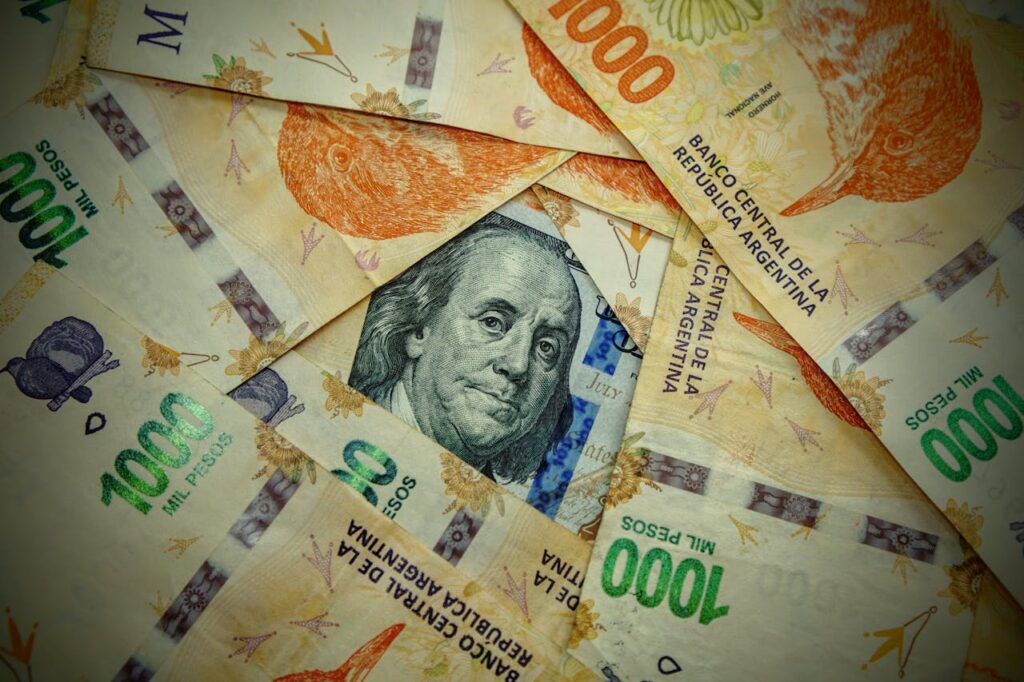If you’re planning a trip to Argentina, this is a topic you’re going to want to be properly clued up about! With so many different exchange rates, things can get confusing when trying to exchange money as a tourist in Argentina. Keep reading to discover how to get the most out of your money!
Understanding inflation in Argentina
You’ve probably heard that Argentina is a country which is no stranger to inflation. Since the 1980s, Argentina has experienced an average yearly inflation rate of over 200%, and consequently, the people of Argentina have somewhat lost confidence in the Argentine peso.
In September 2023, under the official exchange rate, one US dollar would have bought you 350 Argentine pesos. A year before, it would have bought you just 140 pesos.
At the time of writing, in October 2024, the official exchange rate is as such:
- 1 USD = 983 pesos
- 10 pesos
- 20 pesos
- 50 pesos
- 100 pesos
- 200 pesos
- 500 pesos
- 1000 pesos
- 2000 pesos
- 10,000 pesos

Locals in Argentina don’t generally exchange money using the official rates. Instead, a parallel exchange rate exists, which I’ll talk a little more about below.
What is the "dólar blue"?
The dolar blue (or blue dollar) is an unofficial exchange rate between the US dollar and the Argentine peso, parallel to the official rate.
At the time of writing, the current exchange rate of the blue dollar is:
- 1 USD = 1200 pesos
In other words, you’d be receiving roughly an extra 200 pesos per dollar that you exchange, compared to the official rate. See the difference here:
- Official rate: 500 USD = 491,500 pesos
- Blue dollar: 500 USD = 600,000 pesos
But how can this be legal?!
Well…it isn’t. At least not strictly speaking.
The dólar blue is essentially a black market that runs parallel to the official exchange rate, and it isn’t controlled by the government. Whilst this may sound dodgy, it really isn’t. You can find exchange offices (or, “casas de cambio”) that will exchange your dollars at the unofficial rate all over Argentina. They’re not hidden away, and they’re certainly not going to get you in trouble – everyone does it!
The unofficial rate is even used by Western Union for international transfers. This is a popular way of exchanging money for tourists and expats spending longer amounts of time in the country, as it means not having to travel with large amounts of cash.
The dólar blue exists in Argentina as a result of the instability of the peso. Many Argentines choose to save their money in US dollars, rather than in pesos, in order for their money to retain its value.
Where can I exchange money?
You can find casas de cambio all over Argentina.
If you’re staying in Buenos Aires, all you have to do is search “casas de cambio”, and you’ll find a number of different options. Avoid exchanging money in banks, as they will exchange your money at the official rate. If in doubt, the best thing to do is to just ask politely about the rate that each exchange office offers.
You can find the current exchange rate for the blue dollar here: https://dolarhoy.com/cotizaciondolarblue.
Keep in mind that in the unofficial exchange offices, they’re never going to offer the exact rate that you see online – it will always be a little less, usually by 10-20 pesos. This is normal and still a good rate, but any lower than that and you should search elsewhere to see if you can find a better offer.
You’re also (very) likely to come across people in the street shouting “cambio” or “cambio dólar”. These people are called “arbolitos” (little trees), and they will offer you an unofficial rate for your cash and take you to a “cueva” (an unofficial exchange office). Personally, I’ve always stayed away from these people, although I haven’t heard any bad stories. Just be aware that it’s not the best idea to show that you’re carrying large amounts of cash in public!
In the city centre of Buenos Aires, here are a couple of places where I’ve exchanged money in the past:
- Casa de Cambio Barrio Norte, near Alto Palermo shopping centre (also works as a Western Union)
- Casa de Cambio Rimini, in Microcentro
Can I only exchange US dollars at the unofficial rate?
There are some casas de cambio which accept other currencies, like euros, at the unofficial rate, but not all do.
As mentioned previously, Western Union also operate using the parallel rate for the US dollar; this is the same for other currencies too. Mostly, I avoid exchanging cash whilst in Argentina, and instead, I use Western Union to do an international transfer. In my case, I transfer from the British pound and the rate is always a lot better than the official one.
You can find Western Union offices all over Buenos Aires and the rest of Argentina. Sometimes they can get busy, so try to go early in the morning if possible to avoid queues.
What has your experience been with exchanging money in Argentina? Let us know in the comments! If you have any other suggestions, feel free to leave a comment below.


very useful article!!!